Spanish: Cuba Facts - Comprehensive Report on Culture and Economy
VerifiedAdded on 2022/11/23
|7
|984
|216
Report
AI Summary
This report provides a comprehensive overview of Cuba, encompassing its geography, culture, and economy. It begins with basic facts about Cuba, including its location in the Caribbean Sea, its capital Havana, and major cities. The report then delves into Cuba's geography, describing its climate, rivers, lakes, waterfalls, mountains, and rainforests. The cultural section explores the languages spoken, national holidays, major festivals, popular sports, and traditional clothing. It highlights salsa music and the national cuisine, including the popular dish ropa vieja. The report also includes information on Fidel Castro's role in Cuban history and an overview of Cuba's economy, natural resources, and monetary unit. The report uses several references to support the details provided.
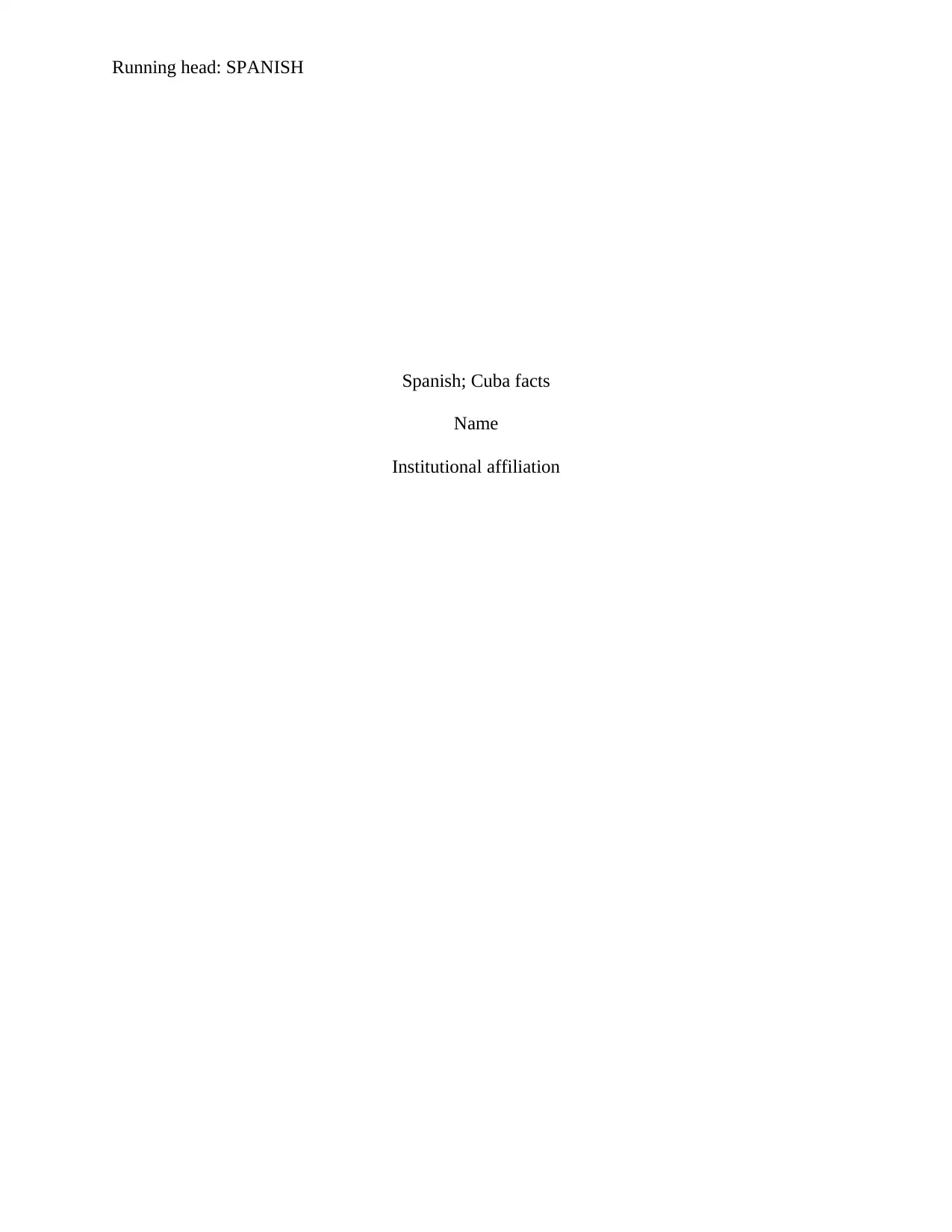
Running head: SPANISH
Spanish; Cuba facts
Name
Institutional affiliation
Spanish; Cuba facts
Name
Institutional affiliation
Paraphrase This Document
Need a fresh take? Get an instant paraphrase of this document with our AI Paraphraser
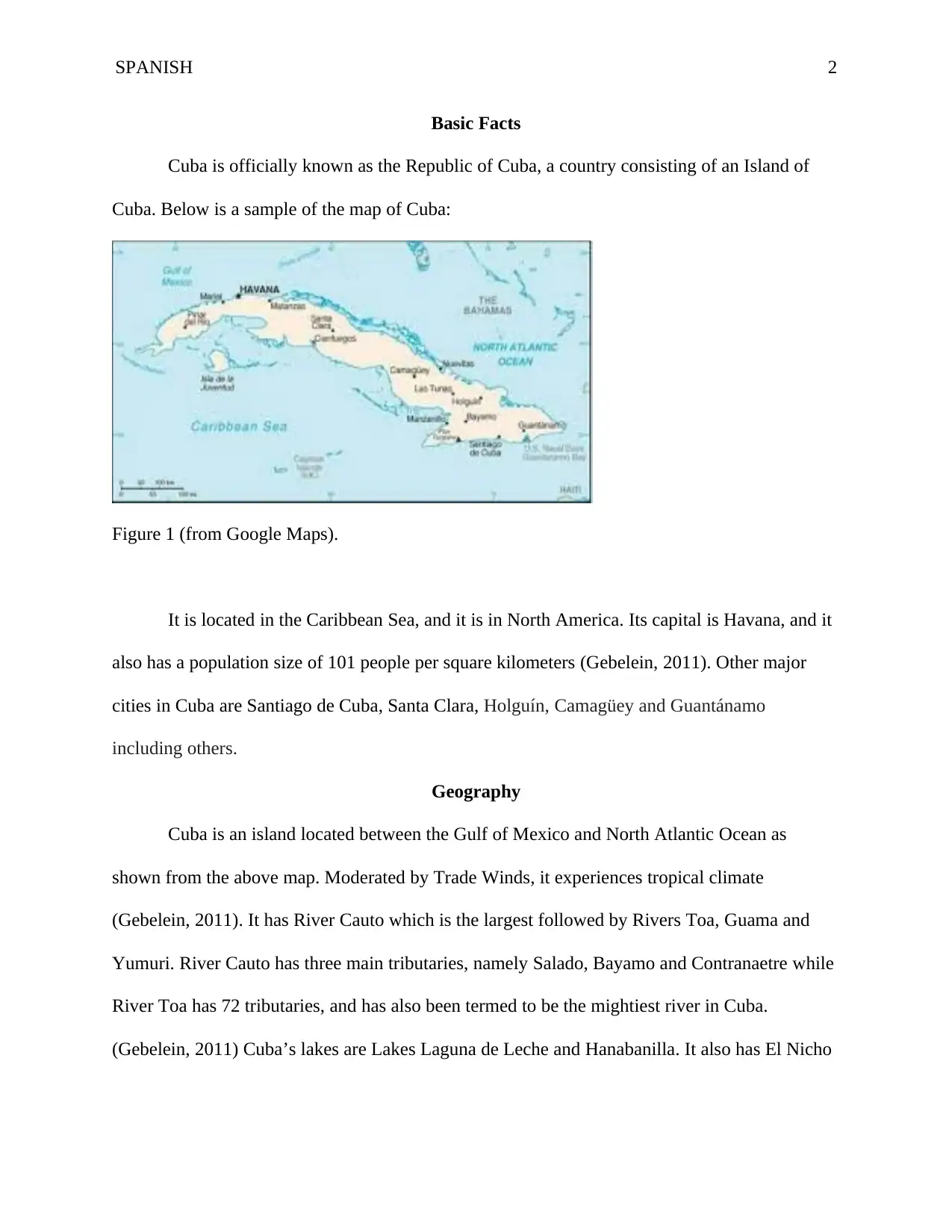
SPANISH 2
Basic Facts
Cuba is officially known as the Republic of Cuba, a country consisting of an Island of
Cuba. Below is a sample of the map of Cuba:
Figure 1 (from Google Maps).
It is located in the Caribbean Sea, and it is in North America. Its capital is Havana, and it
also has a population size of 101 people per square kilometers (Gebelein, 2011). Other major
cities in Cuba are Santiago de Cuba, Santa Clara, Holguín, Camagüey and Guantánamo
including others.
Geography
Cuba is an island located between the Gulf of Mexico and North Atlantic Ocean as
shown from the above map. Moderated by Trade Winds, it experiences tropical climate
(Gebelein, 2011). It has River Cauto which is the largest followed by Rivers Toa, Guama and
Yumuri. River Cauto has three main tributaries, namely Salado, Bayamo and Contranaetre while
River Toa has 72 tributaries, and has also been termed to be the mightiest river in Cuba.
(Gebelein, 2011) Cuba’s lakes are Lakes Laguna de Leche and Hanabanilla. It also has El Nicho
Basic Facts
Cuba is officially known as the Republic of Cuba, a country consisting of an Island of
Cuba. Below is a sample of the map of Cuba:
Figure 1 (from Google Maps).
It is located in the Caribbean Sea, and it is in North America. Its capital is Havana, and it
also has a population size of 101 people per square kilometers (Gebelein, 2011). Other major
cities in Cuba are Santiago de Cuba, Santa Clara, Holguín, Camagüey and Guantánamo
including others.
Geography
Cuba is an island located between the Gulf of Mexico and North Atlantic Ocean as
shown from the above map. Moderated by Trade Winds, it experiences tropical climate
(Gebelein, 2011). It has River Cauto which is the largest followed by Rivers Toa, Guama and
Yumuri. River Cauto has three main tributaries, namely Salado, Bayamo and Contranaetre while
River Toa has 72 tributaries, and has also been termed to be the mightiest river in Cuba.
(Gebelein, 2011) Cuba’s lakes are Lakes Laguna de Leche and Hanabanilla. It also has El Nicho
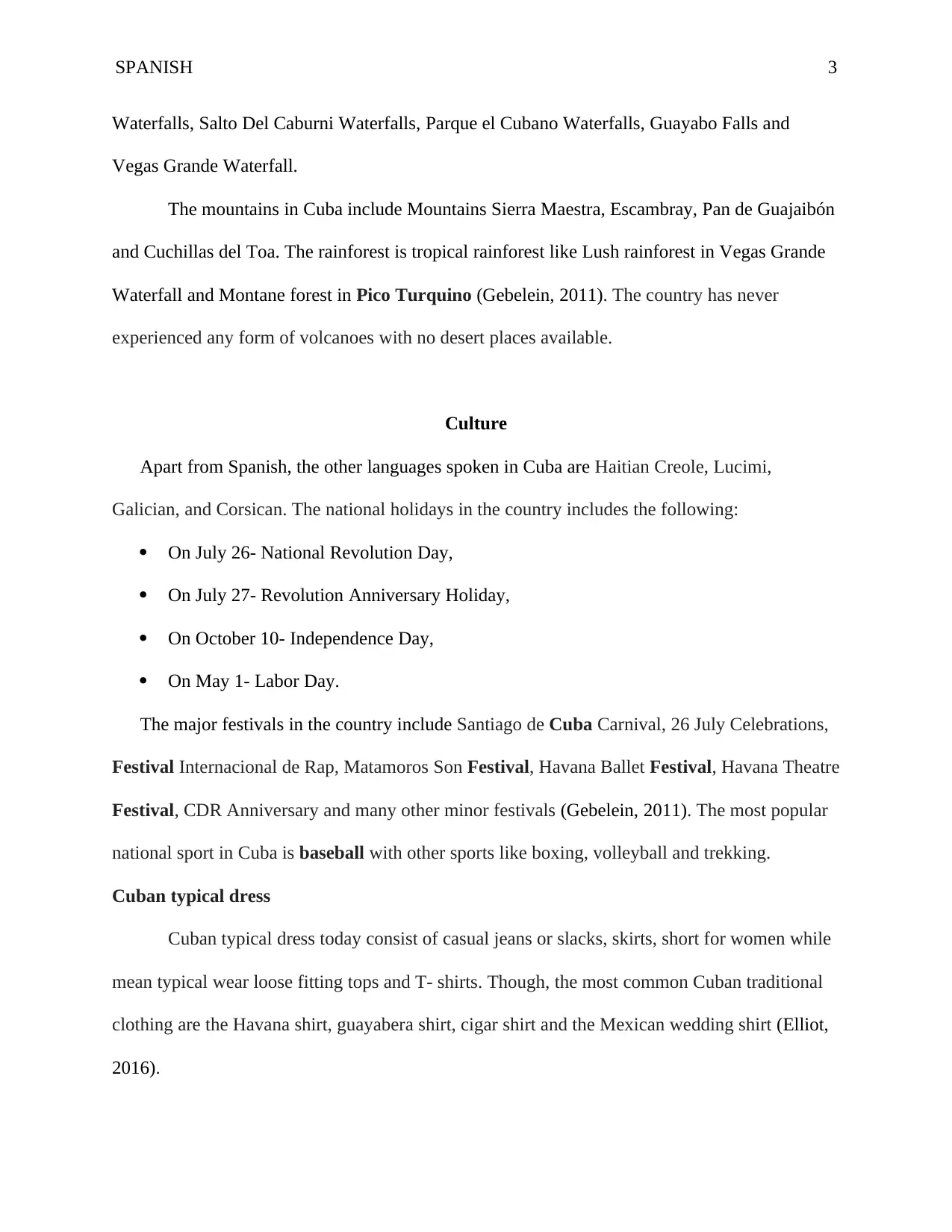
SPANISH 3
Waterfalls, Salto Del Caburni Waterfalls, Parque el Cubano Waterfalls, Guayabo Falls and
Vegas Grande Waterfall.
The mountains in Cuba include Mountains Sierra Maestra, Escambray, Pan de Guajaibón
and Cuchillas del Toa. The rainforest is tropical rainforest like Lush rainforest in Vegas Grande
Waterfall and Montane forest in Pico Turquino (Gebelein, 2011). The country has never
experienced any form of volcanoes with no desert places available.
Culture
Apart from Spanish, the other languages spoken in Cuba are Haitian Creole, Lucimi,
Galician, and Corsican. The national holidays in the country includes the following:
On July 26- National Revolution Day,
On July 27- Revolution Anniversary Holiday,
On October 10- Independence Day,
On May 1- Labor Day.
The major festivals in the country include Santiago de Cuba Carnival, 26 July Celebrations,
Festival Internacional de Rap, Matamoros Son Festival, Havana Ballet Festival, Havana Theatre
Festival, CDR Anniversary and many other minor festivals (Gebelein, 2011). The most popular
national sport in Cuba is baseball with other sports like boxing, volleyball and trekking.
Cuban typical dress
Cuban typical dress today consist of casual jeans or slacks, skirts, short for women while
mean typical wear loose fitting tops and T- shirts. Though, the most common Cuban traditional
clothing are the Havana shirt, guayabera shirt, cigar shirt and the Mexican wedding shirt (Elliot,
2016).
Waterfalls, Salto Del Caburni Waterfalls, Parque el Cubano Waterfalls, Guayabo Falls and
Vegas Grande Waterfall.
The mountains in Cuba include Mountains Sierra Maestra, Escambray, Pan de Guajaibón
and Cuchillas del Toa. The rainforest is tropical rainforest like Lush rainforest in Vegas Grande
Waterfall and Montane forest in Pico Turquino (Gebelein, 2011). The country has never
experienced any form of volcanoes with no desert places available.
Culture
Apart from Spanish, the other languages spoken in Cuba are Haitian Creole, Lucimi,
Galician, and Corsican. The national holidays in the country includes the following:
On July 26- National Revolution Day,
On July 27- Revolution Anniversary Holiday,
On October 10- Independence Day,
On May 1- Labor Day.
The major festivals in the country include Santiago de Cuba Carnival, 26 July Celebrations,
Festival Internacional de Rap, Matamoros Son Festival, Havana Ballet Festival, Havana Theatre
Festival, CDR Anniversary and many other minor festivals (Gebelein, 2011). The most popular
national sport in Cuba is baseball with other sports like boxing, volleyball and trekking.
Cuban typical dress
Cuban typical dress today consist of casual jeans or slacks, skirts, short for women while
mean typical wear loose fitting tops and T- shirts. Though, the most common Cuban traditional
clothing are the Havana shirt, guayabera shirt, cigar shirt and the Mexican wedding shirt (Elliot,
2016).
⊘ This is a preview!⊘
Do you want full access?
Subscribe today to unlock all pages.

Trusted by 1+ million students worldwide
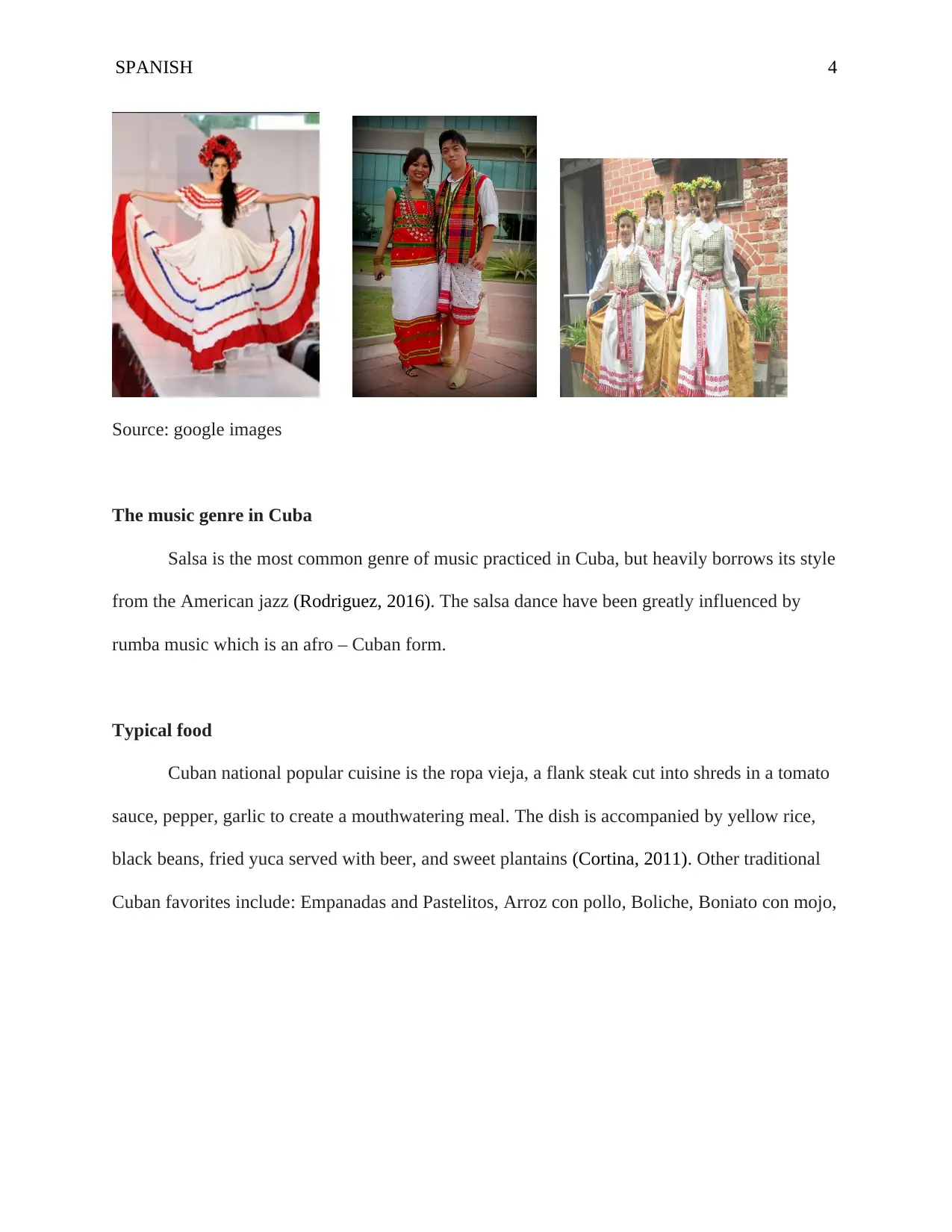
SPANISH 4
Source: google images
The music genre in Cuba
Salsa is the most common genre of music practiced in Cuba, but heavily borrows its style
from the American jazz (Rodriguez, 2016). The salsa dance have been greatly influenced by
rumba music which is an afro – Cuban form.
Typical food
Cuban national popular cuisine is the ropa vieja, a flank steak cut into shreds in a tomato
sauce, pepper, garlic to create a mouthwatering meal. The dish is accompanied by yellow rice,
black beans, fried yuca served with beer, and sweet plantains (Cortina, 2011). Other traditional
Cuban favorites include: Empanadas and Pastelitos, Arroz con pollo, Boliche, Boniato con mojo,
Source: google images
The music genre in Cuba
Salsa is the most common genre of music practiced in Cuba, but heavily borrows its style
from the American jazz (Rodriguez, 2016). The salsa dance have been greatly influenced by
rumba music which is an afro – Cuban form.
Typical food
Cuban national popular cuisine is the ropa vieja, a flank steak cut into shreds in a tomato
sauce, pepper, garlic to create a mouthwatering meal. The dish is accompanied by yellow rice,
black beans, fried yuca served with beer, and sweet plantains (Cortina, 2011). Other traditional
Cuban favorites include: Empanadas and Pastelitos, Arroz con pollo, Boliche, Boniato con mojo,
Paraphrase This Document
Need a fresh take? Get an instant paraphrase of this document with our AI Paraphraser
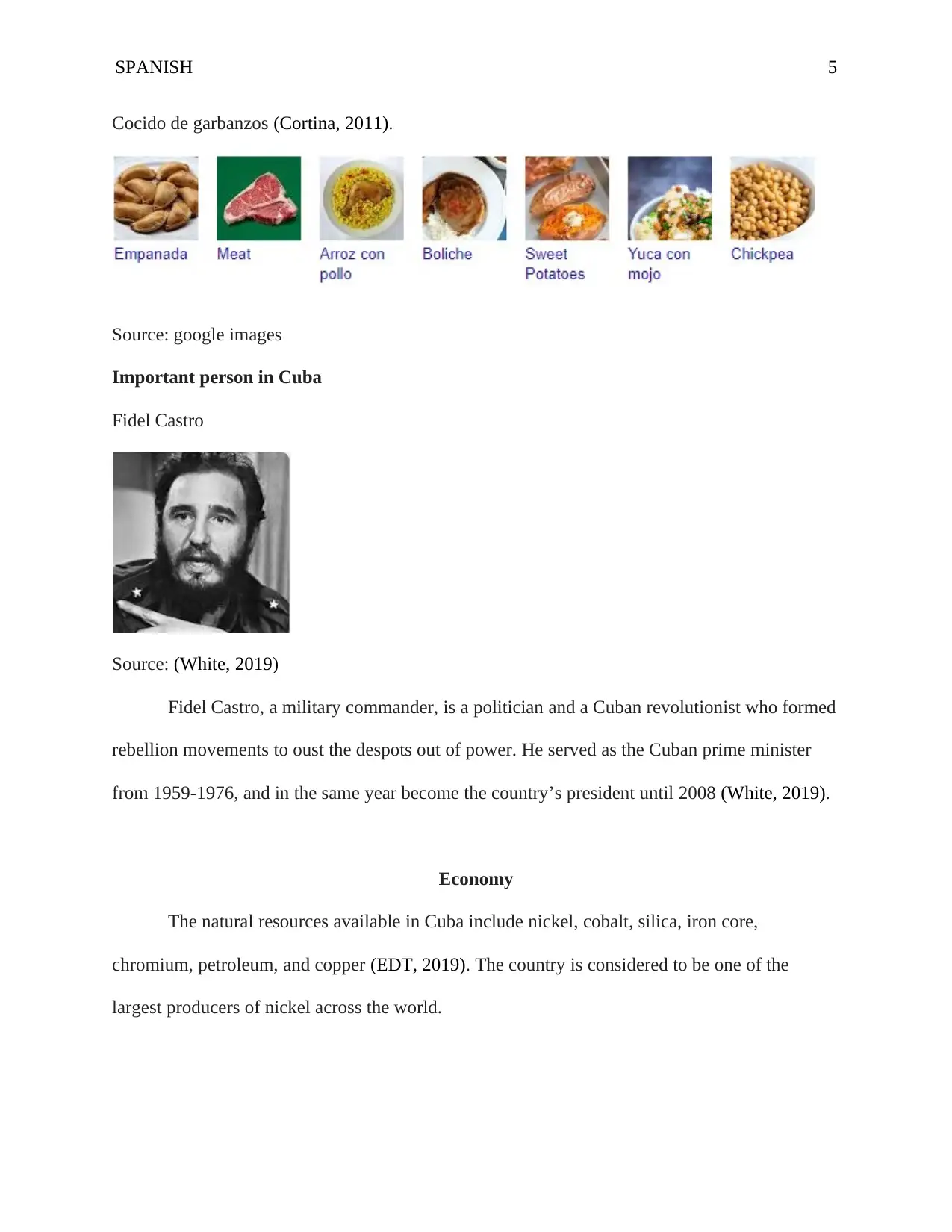
SPANISH 5
Cocido de garbanzos (Cortina, 2011).
Source: google images
Important person in Cuba
Fidel Castro
Source: (White, 2019)
Fidel Castro, a military commander, is a politician and a Cuban revolutionist who formed
rebellion movements to oust the despots out of power. He served as the Cuban prime minister
from 1959-1976, and in the same year become the country’s president until 2008 (White, 2019).
Economy
The natural resources available in Cuba include nickel, cobalt, silica, iron core,
chromium, petroleum, and copper (EDT, 2019). The country is considered to be one of the
largest producers of nickel across the world.
Cocido de garbanzos (Cortina, 2011).
Source: google images
Important person in Cuba
Fidel Castro
Source: (White, 2019)
Fidel Castro, a military commander, is a politician and a Cuban revolutionist who formed
rebellion movements to oust the despots out of power. He served as the Cuban prime minister
from 1959-1976, and in the same year become the country’s president until 2008 (White, 2019).
Economy
The natural resources available in Cuba include nickel, cobalt, silica, iron core,
chromium, petroleum, and copper (EDT, 2019). The country is considered to be one of the
largest producers of nickel across the world.
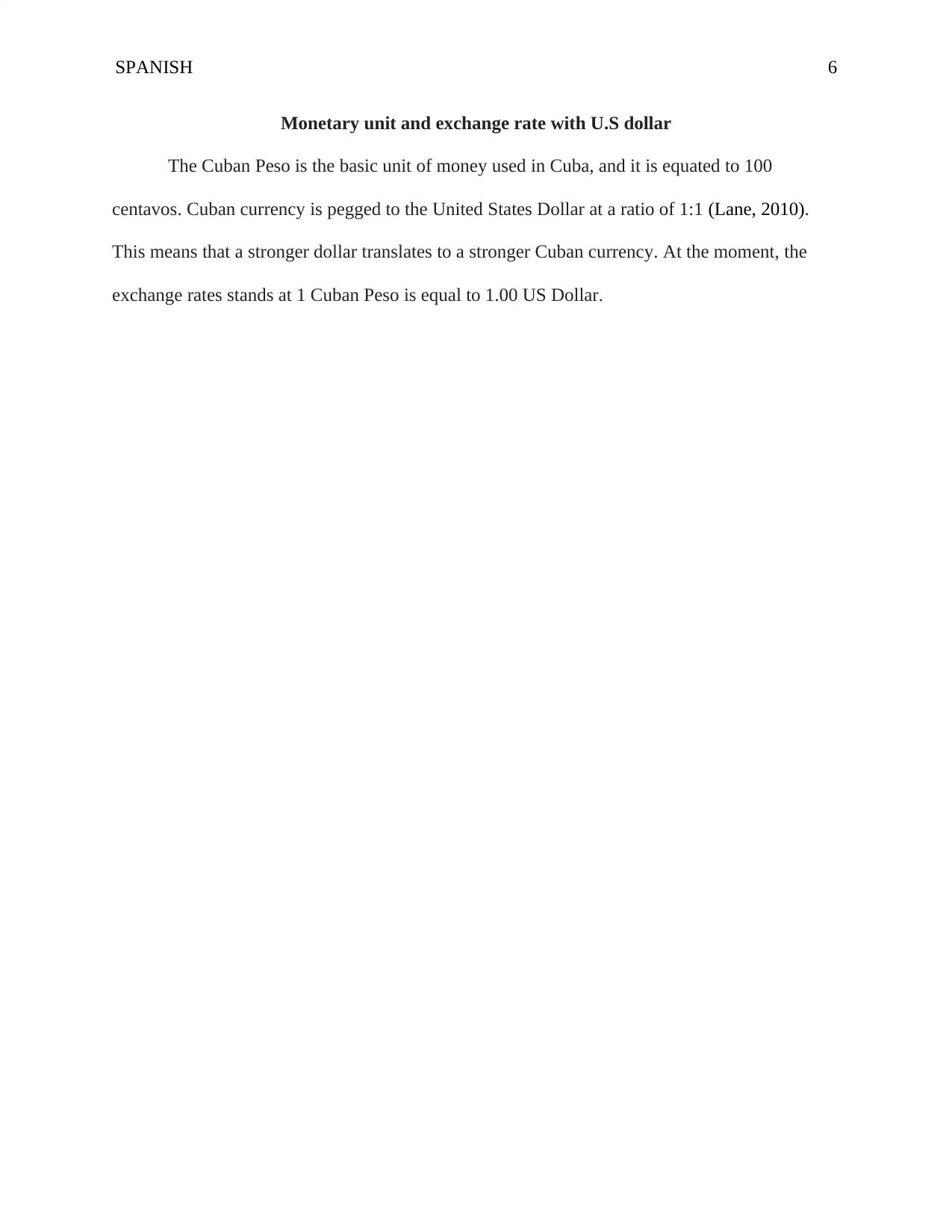
SPANISH 6
Monetary unit and exchange rate with U.S dollar
The Cuban Peso is the basic unit of money used in Cuba, and it is equated to 100
centavos. Cuban currency is pegged to the United States Dollar at a ratio of 1:1 (Lane, 2010).
This means that a stronger dollar translates to a stronger Cuban currency. At the moment, the
exchange rates stands at 1 Cuban Peso is equal to 1.00 US Dollar.
Monetary unit and exchange rate with U.S dollar
The Cuban Peso is the basic unit of money used in Cuba, and it is equated to 100
centavos. Cuban currency is pegged to the United States Dollar at a ratio of 1:1 (Lane, 2010).
This means that a stronger dollar translates to a stronger Cuban currency. At the moment, the
exchange rates stands at 1 Cuban Peso is equal to 1.00 US Dollar.
⊘ This is a preview!⊘
Do you want full access?
Subscribe today to unlock all pages.

Trusted by 1+ million students worldwide
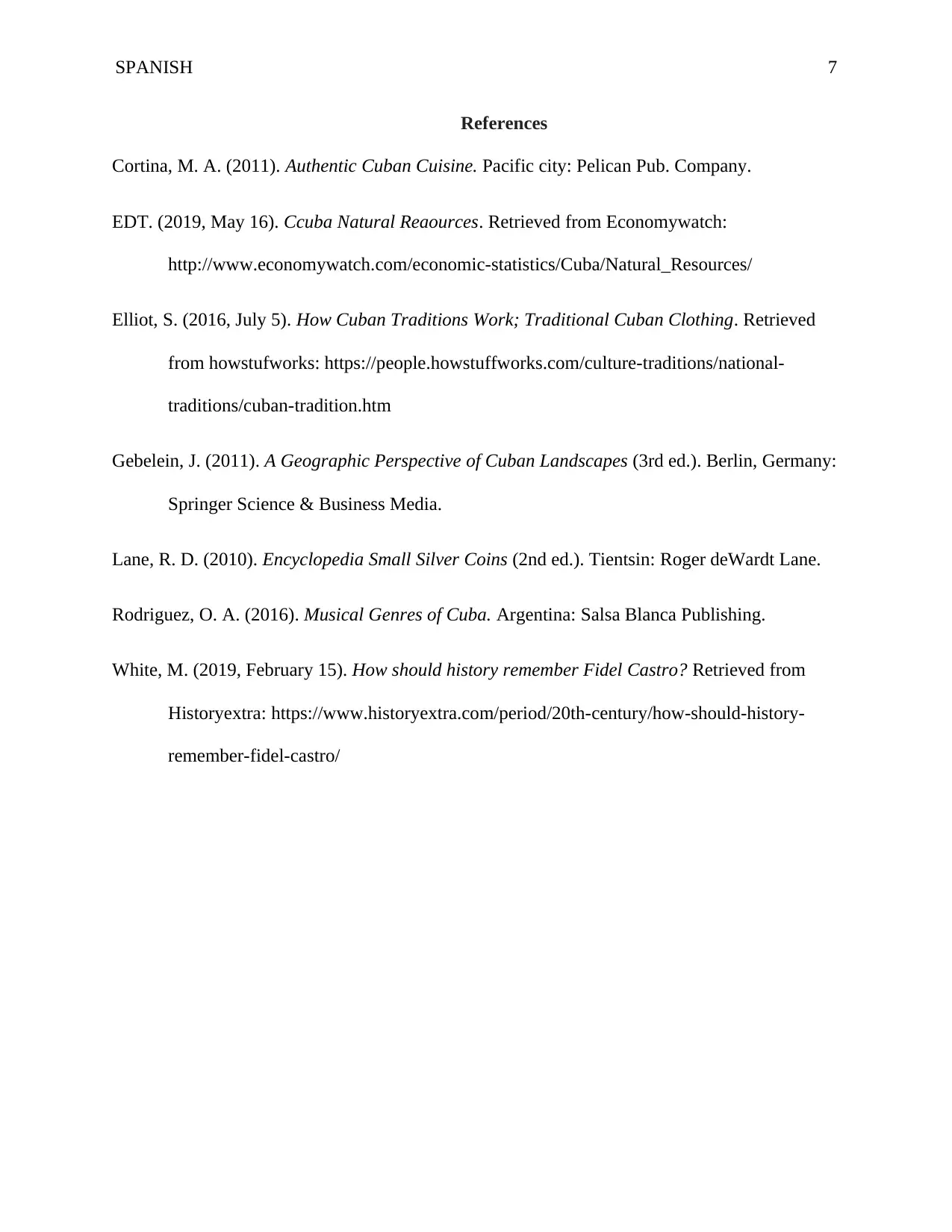
SPANISH 7
References
Cortina, M. A. (2011). Authentic Cuban Cuisine. Pacific city: Pelican Pub. Company.
EDT. (2019, May 16). Ccuba Natural Reaources. Retrieved from Economywatch:
http://www.economywatch.com/economic-statistics/Cuba/Natural_Resources/
Elliot, S. (2016, July 5). How Cuban Traditions Work; Traditional Cuban Clothing. Retrieved
from howstufworks: https://people.howstuffworks.com/culture-traditions/national-
traditions/cuban-tradition.htm
Gebelein, J. (2011). A Geographic Perspective of Cuban Landscapes (3rd ed.). Berlin, Germany:
Springer Science & Business Media.
Lane, R. D. (2010). Encyclopedia Small Silver Coins (2nd ed.). Tientsin: Roger deWardt Lane.
Rodriguez, O. A. (2016). Musical Genres of Cuba. Argentina: Salsa Blanca Publishing.
White, M. (2019, February 15). How should history remember Fidel Castro? Retrieved from
Historyextra: https://www.historyextra.com/period/20th-century/how-should-history-
remember-fidel-castro/
References
Cortina, M. A. (2011). Authentic Cuban Cuisine. Pacific city: Pelican Pub. Company.
EDT. (2019, May 16). Ccuba Natural Reaources. Retrieved from Economywatch:
http://www.economywatch.com/economic-statistics/Cuba/Natural_Resources/
Elliot, S. (2016, July 5). How Cuban Traditions Work; Traditional Cuban Clothing. Retrieved
from howstufworks: https://people.howstuffworks.com/culture-traditions/national-
traditions/cuban-tradition.htm
Gebelein, J. (2011). A Geographic Perspective of Cuban Landscapes (3rd ed.). Berlin, Germany:
Springer Science & Business Media.
Lane, R. D. (2010). Encyclopedia Small Silver Coins (2nd ed.). Tientsin: Roger deWardt Lane.
Rodriguez, O. A. (2016). Musical Genres of Cuba. Argentina: Salsa Blanca Publishing.
White, M. (2019, February 15). How should history remember Fidel Castro? Retrieved from
Historyextra: https://www.historyextra.com/period/20th-century/how-should-history-
remember-fidel-castro/
1 out of 7
Your All-in-One AI-Powered Toolkit for Academic Success.
+13062052269
info@desklib.com
Available 24*7 on WhatsApp / Email
![[object Object]](/_next/static/media/star-bottom.7253800d.svg)
Unlock your academic potential
Copyright © 2020–2025 A2Z Services. All Rights Reserved. Developed and managed by ZUCOL.